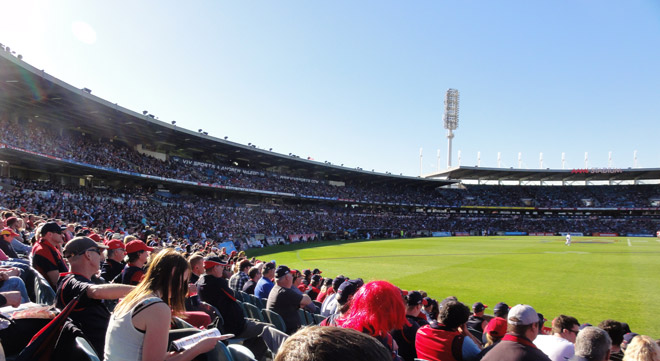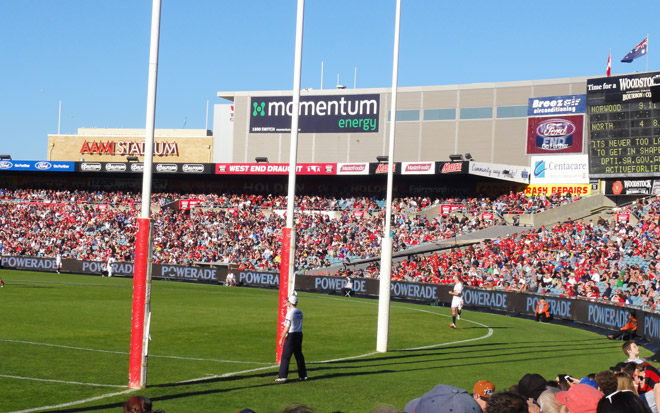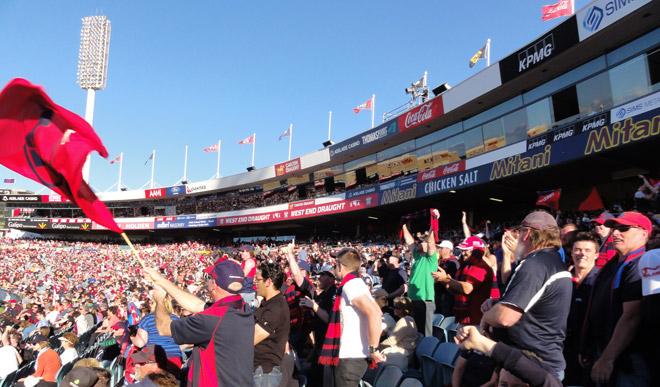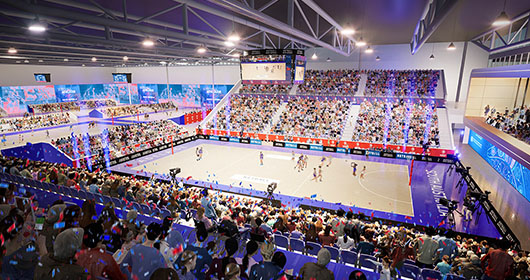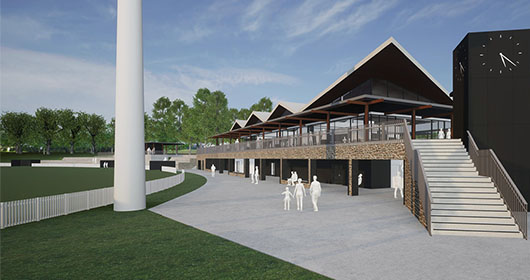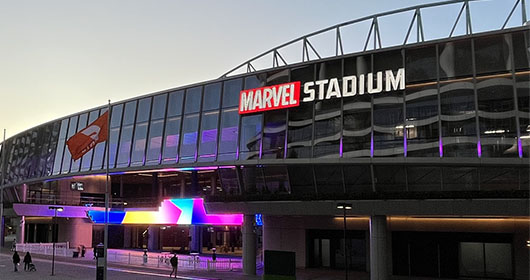Farewell to Football Park - A South Australian Fan Favourite

An era in Australian sport concluded on Sunday 6 October 2013 with the hosting of the South Australia National Football League (SANFL) Grand Final between Norwood and North Adelaide at AAMI Stadium in Adelaide. Better known to punters as Football Park or colloquially 'Footy Park', the stadium witnessed its last ever major sporting contest with AFL games and the SANFL Grand Final set to move to a redeveloped 50,000 capacity Adelaide Oval in 2014. Bon Jovi will rock it one last time in December but after that its future remains in the air.
Not only was it the last Grand Final, the occasion marked a key juncture in Australian stadium and sport planning for it signified the final transition between modern and postmodern sport. Upon opening in 1974, the stadium which is fashioned in a vast concrete bowl with a lowered playing surface was the epitome of the modern stadium of the 1970s. Of Brutalist design, its location on the reclaimed swamps of suburban West Lakes was the epithet of the 'Great Australian Dream' as it specifically catered for families of fans that lived in the suburbs and travelled en masse by car.
The parallels between Football Park and VFL Park in Melbourne, another modern super stadium which now no longer exists for its original purpose, are endless. Not only were they built a few years apart and owned by their respective leagues, they shared similar architectural design, had a distinctive hump on the playing surface to aid drainage, didn't reach their intended capacities and were the catalyst behind urban development in new metropolitan growth areas. More poignantly, however, the two stadiums were fashioned to free the game of Australian Rules football in both South Australia and Victoria from the overbearing influence of cricket and the elitism of their membership base, notably the South Australian Cricket Association (SACA) and the Melbourne Cricket Club (MCC) who were the prevailing ground managers at their respective venues - Adelaide Oval and the Melbourne Cricket Ground (MCG). "For many SANFL fans, Football Park represented freedom" noted Ryan Boyle, a Central District fanatic, adding "It was ours."
However much like its Victorian counterpart, Football Park suffered as a consequence of its modern style and location. Built on the reliance of the motorcar, the surrounding road infrastructure wasn't adequate enough to cater for this upsurge of use leading to traffic jams and a lack of parking options for big games. Erroneously, despite having the Hendon railway branch only 1.5 kilometres from Football Park, when closed in 1980 the rail reservation became a section of West Lakes Boulevard, the main thoroughfare of access to all but a few parts of the Adelaide metropolitan area. Further adding to commuter stress, the connecting section to Port Road - the major north-west arterial - was and still is one lane, echoing Jacksons Road, the connector adjacent to VFL Park.
Although Victorian State Government intervention stifled the growth of VFL Park leading to its eventual demise, evolving planning policy and generational cycles of boom and bust precipitated this event. Meanwhile Football Park was allowed to thrive and continue. New seating and the construction of the Northern Stand signified the intent of the ground to stay for the long term. Unlike Waverley, it didn't have a stigma. On the contrary it was viewed with fondness. West Adelaide fan Chris Micik described it as the "theatre of my childhood ... I don't know how I feel about its closing ... it's an emotionally numbing feeling." Meanwhile Julian Stockwell, a Glenelg supporter recalled: "hell I even saw a baseball game there back in the early 80s."
Often people from the eastern states jest that Adelaide is 30 minutes and 10 years behind the rest but in a stadium planning sense this hypothesis holds true. As Burke and Woolcock have explained in their academic study on transport and stadium locations, Melbourne and Brisbane have witnessed shifts in what they call stadium transit-orientated development. This has seen the replacement of modern (outer) suburban stadiums at VFL Park and QEII Stadium (now QSAC) that catered to the motorcar and had poor public transport options with postmodern city-based facilities in Etihad Stadium and Suncorp Stadium which are supported by multiple public transport options. Moreover, they have minimal spaces for spectator car parking. This phase of stadium transformations occurred over ten years ago. Adelaide is only seeing this style of development now.
For the last game at Footy Park I flew from Sydney to Adelaide just for the Grand Final. Being the stadium aficionado I wanted to witness the last hurrah of modern sport in person. Unlike the final AFL match at Waverley in 1999 there seemed to be no protests or tears, a strange proposition considering it was often negatively called 'Arctic Park'. Football Park's final fling instead witnessed good memories and affection for a ground which generations of South Australians grew up with. More tellingly, all those in attendance knew their sporting destiny now lies in the northern parklands of 'Light's Vision' on the banks of the River Torrens. Most notable was the South Australian version of the tailgate in the car park, a ritual that will be lost when Adelaide Oval reopens.
Perhaps fittingly I was stuck in a monstrous traffic jam before the game which stretched at least five kilometres from the ground all the way along Port Road to Woodville. So much so I was able to duck into a bottle shop and get one for the road without losing much ground. Parking, well, that was a totally different beast altogether. There seemed to be nothing available. Everything was full. Even in the neighbouring Westfield shopping centre. An eventual space far from the ground saw me and my friends enter after quarter time. The contest lacked intensity for such a high stakes match with the Redlegs of Norwood prevailing by 40 points for their 29th SANFL premiership. To be honest I wasn't there just for the game. Rather it was to sate my urge of what noted English football ground commentator Simon Inglis declares as 'stadiumitis'.

